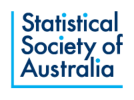Manuel Herrera PhD Senior Research Associate, Institute of Manufacturing, University of Cambridge
Manuel Herrera who is the 2021 Frank Hansford-Miller Fellow gave the WA Branch November seminar virtually. His stated intention was to show fellow statisticians what it is like to work with engineering problems using statistics and statistical methods.
As noted by Brenton the seminar fitted in perfectly with the Fellowship since Frank Hansford-Miller was a person who championed Applied Statistics and how it supported the fabric of society and even the politics of the day.
Manuel expressed pleasure in being able to explain to fellow statisticians the problems that he had faced in engineering where he had been working as long ago as 12 years for instance in looking at water supply systems, initially resolving problems to do with leakages using clustering methods, but also following up with time series methods where he made some useful predictions for demand management and infrastructure operation.
Different projects included smart boards maintenance and optimal operation of cranes in a port in this case in Felixstowe where there are 31 quay cranes, 82 yard cranes and ships having 20,000 containers with containers roughly around 35 tonnes.
Trying to ascertain where crane failure and maintenance was needed and time series provided a way through, but it was important to look for anomalies not only in the current asset but also in neighbouring assets. It was noted that while digitization was becoming normal and there are all the incumbent problems of big data, there is importance of understanding the problems at hand.
Different problems exist in long-haul internet backbone networks… again using anomaly detection in time series. Again, we are looking at anomalies in time series not only in the network node, that may represent a router station, but also anomalies in neighbouring network areas for an automated and optimal network operation and control. There are lots of challenges in a more than ever interconnected world that needs to work towards a high capacity, low latency and high accessibility internet service
Manuel then introduced a paradigm regarding digital transformation based in 5 ascending steps, Step 1. Digitization of the information, step 2 Organize the information, step 3 Automate processes using digital technologies and information to transform individual institutional operations, step 4 Streamline processes, step 5 Transform the institution which briefly summarized involve Digital transformations.
Manuel then referred to IoT and 5G solutions and better management of systems. Here IoT is the internet of things and giving information on many devices leading to big data that needs to be efficiently managed for an optimal decision making and infrastructure (asset) monitoring. Discussion involved how to work with managing data coming from IoT etcetera? Links further to Blockchains that show their ability to secure information sharing, so we don’t need to know the whole system but maybe a part of the system and neighbouring parts. That will be a key technological tool for further modelling interdependencies, for instance, between multiple urban systems.
Manuel noted the idea of having a digital twin in asset management and the opportunities offered by that.
His personal view is that it is not about technology use, if any; it is about the way one can extract maximum information [from the available technology] for a better infrastructure operation and management.
Traditional thinking was analysing data in a single analysis, but we are more often now seeing many internet connections and now we may be examining several layers in a dynamic relationship. Multilayer networks are coming to the fore. The challenge is to be able to work with traditional time series in a network dynamic.
Manuel further described predictive analytics blending time series and regression analysis tools to optimization of systems. If we detect anomalies, we can interactively complete optimization of decision making.
Manuel concluded that we must explain what we are doing and how training the network to go differently in order that decision makers may trust our involvement.
His personal view was that it is not about methodology use; it is about an approach of proper engineering challenges for a better infrastructure system operation and subsequent management.
Manuel then explained his viewpoint by looking at a long-haul internet backbone network
The challenges include anomaly detection (for very long time series). Covid has revealed a new phenomenon in interrupted time series and now the IoT reveals another dimension.
Manuel fielded several questions and we had insight of a statistician working in engineering.
Brenton R Clarke
